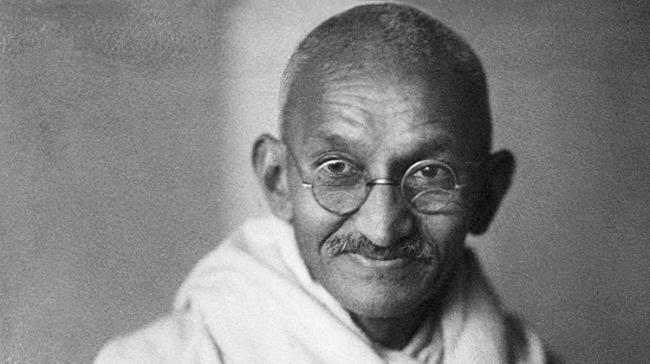The Gandhian Way Of Life Today

Ravi Valluri
About Mahatma Gandhi Albert Einstein was to say,
‘Generations to come, it may well be, will scarce believe that such a man as this one ever inflesh and blood walked upon this Earth.’
Indian political and social firmament in the twentieth century was populated with several iconic figures, but none commanded the respect or were adorned with the aura of Mahatma Gandhi. It is reckoned that for aeons no personality will ever be able to capture the imagination as the Mahatma did.
In the age of subjugation and apartheid, it would have required tremendous courage,resolve and pluck for Mohandas Karamchand Gandhi to travel by a first-class compartment on the train to Pretoria. And after he was ejected from the train at Pietermaritzburg, he displayed remarkable fortitude and audacity to stay the entire night at the station in a waiting hall.
The seeds of Satyagraha were sown in his intrepid mind that chilly winter night, on June the 7th 1893.Gandhian strategy entailed political right and self-government ought to develop gradually in a series of progressive stages. He maintained liberalism and never cut the umbilical cord with the potentate (the British rulers).
The politics of Gandhiji were all embracing. It was a struggle against the policy of Divide-et-impera adopted by the British, a combat against the orthodoxy and prevalent social evils; negotiate with the masters to seek redressal of issues confronting the masses. As non-violence was his credo, it was important to adopt the tactic of mass action as against mass insurrection.
He was staunchly inimical to class struggle, violent upheavals and continuously strove for resolution through parleys and dialogue. Violent thoughts and aggression were inimical to his strategy as he appreciated the brutality of the British forces. Thus, he singularly gave up the Civil Disobedience movement following the burning of the police post at Chauri Chaura, where 22 policemen were killed.
He abhorred violence and any form of killing was an anathema to him. This cardinal principle perhaps may have been implanted in his fertile mind through his Jain-Hindu upbringing. However, he was deeply catholic in his temperament and for him there was hardly any difference between various religious professed and practised by the denizens of this country.
As he appreciated divisive forces at work, Bapu devised his political philosophy, techniques and programmes to encompass all forces and different sections of the society.
He rejected communism and the Marxian ideology as he was a practising Hindu and a firm believer in religion and spirituality. To him religion was not opium of the masses. Hindu-Muslim unity was extremely close to his heart and he was tragically felled by the bullets of an assassin while trying to maintain communal harmony.
The potent weapon of Satyagraha which achieved astonishing success in South Africa had convinced his robust mind that all sections of the society could join hands and embark upon the freedom struggle in unison. In his arsenal were the Direct Action, Satyagraha and
Civil Disobedience which he pioneered in the Champaran.
The imagery of Gandhiji was to establish a direct contact with the masses. The apparel worn by him was similar to those worn by the toiling masses. He cast away the British-stitched clothes and exhorted people of India to participate in mass bonfires of alien and foreign goods.
The template and cornerstone of his political and social philosophy became the establishment of Ram Rajya (not the euphemism for a Hindu state but as an ideal and egalitarian society) through the 3 Ss- Swaraj, Satyagraha and Swadeshi.
Likewise, non-violence, non-cooperation and civil disobedience were a three-pronged tactic he unleashed from his arsenal. In the magazine of his armoury were also the twin missiles of truth and fasting. This was a comprehensive positive mind-set of the Mahatma to achieve the desired goals of political and social emancipation of an enslaved India.
However, he was a disillusioned man when Pandit Nehru spoke those immortal lines, ‘At the stroke of midnight as the whole world sleeps …’ He was deeply anguished with the partitioning of the country. He shed a few tears in solitude and wiped some more at Noakhali,that fateful night …
It would be interesting to mention that there were two occasions when the Mahatma did not undertake a fast. One, to stave off the capital punishment awarded to Bhagat Singh and others and secondly when the country was partitioned. Even the Mahatma realised the futility of undertaking such an exercise under the prevailing circumstances.
In the ultimate analysis Gandhiji gave the nationalist struggle a deeper connotation and meaning. His strategy, philosophy, technique proved efficacious in approach and nature.
More importantly, it fired the imagination of several leaders across the world to wage a struggle for civil liberty; be it Martin Luther King Jr, Aung San Suu Kyi, Nelson Mandela, Reverend Jesse Jackson, Barrack Obama, and more recently in India--Anna Hazare.
Also Read: 19th NCPEDP-Mindtree Helen Keller Awards Recipients -TATA Trent, Dr. Reddy’s Foundation & BS Nagesh





